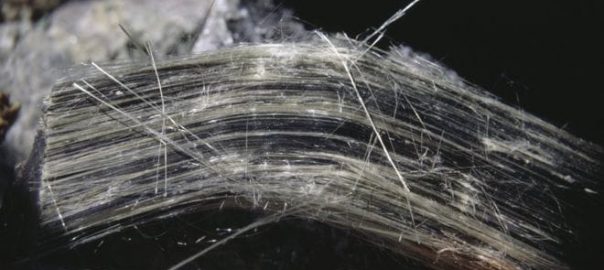How Dangerous is Asbestos?

Asbestos is technically a legal or commercial term referring to a number of minerals from the amphibole and serpentine families. There are 6 main types of asbestos including Chrysotile (white asbestos), Crocidolite (blue asbestos), Amosite (brown asbestos), Anthophyllite, Tremolite and Actinolite.
Chrysotile is the mineral that most people are familiar with and used in insulation, automobile brake linings, ceilings, walls, roofs, ducts, pipes and appliances.
Asbestos fibres are flexible and easy to work with and have strong fire resistant properties. The material is also resistant to electricity and corrosion and is a good insulator in its pure form making it a favourite and natural material to use in home insulation before the serious health risks were discovered. Asbestos can also be mixed into plastic, cement, paper or cloth to make it stronger.
Asbestos use was banned in Canada in 2018 except for very limited uses.
Anecdote: Pliny the Elder (23 AD – 79 AD), the celebrated Roman historian, philosopher, author and naturalist documented the link between asbestos and respiratory disease during the early Roman Empire. He noted that slaves who mined or wove asbestos suffered serious lung disease.
When Asbestos is Dangerous
Without understating the health risks associated with asbestos exposure, the mineral isn’t a danger in all circumstances. As long as the asbestos fibres are not airborne or ‘friable’ then the material is safe. A good example is floor or ceiling tiles containing asbestos are not dangerous as long as they are not damaged.
The danger with asbestos occurs when it is inhaled or ingested. Symptoms can take up to 25 years after exposure to manifest. The main factors that determine the chances of contracting asbestos-related illnesses after exposure are:
- Age- younger children and older citizens tend to be more prone to asbestos-related diseases.
- Duration of exposure – the longer and more frequent the exposure the more likely to develop the disease.
- Amount of exposure – there is no such thing as a safe amount of exposure but naturally, more asbestos exposure increases the chances of infection.
- Smoking – experts agree that smokers are at higher risk of disease after exposure to asbestos than non-smokers.
Diseases Associated With Asbestos Exposure
The human body cannot get rid of or break down asbestos fibres once they reach the lungs or body tissue. It is, however, possible to remove them if trapped in mucous membranes in the throat and nose. The diseases commonly associated with asbestos exposure include;
Asbestosis: this is a non-cancerous respiratory illness but is still chronic and serious. Symptoms include crackling noises in the lungs when inhaling and shortness of breath. This disease is known to cause cardiac failure in its later stages. There is no permanent treatment for asbestosis. This disease is more common with people who work closely with asbestos and extremely rare in common exposures such as living in a house with asbestos insulation.
Mesothelioma: this is a rare cancer of the chest, lung linings, abdomen and sometimes the heart. Nearly all reported cases of mesothelioma have been linked back to asbestos exposure. This disease is also common with constant and excessive exposure such as people working or living near asbestos mines.
Lung Cancer: lung cancer is responsible for the most deaths linked to asbestos exposure. People who work directly with asbestos are at a disproportionately higher risk of contracting lung cancer than the general population. Asbestos exposure has also been linked to a number of other cancers including in the oral cavity, esophagus, larynx, kidney and stomach.
What to Do About Asbestos Insulation
Make no mistake, asbestos is a toxic substance and it can make you severely ill. There is no safe way to remove it yourself without the proper training and specialized equipment. You also need to dispose of the toxic material properly and may incur fines and other punishment if done improperly.
Keep in mind that asbestos is typically considered ‘safe’ as long as it hasn’t been disturbed and the fibres or dust isn’t airborne where there is a risk of ingestion or inhalation. The very act of attempting to remove the insulation is what makes it dangerous.
Hire an attic insulation removal company in Toronto that has experience dealing with asbestos insulation. The experts will cordon off the attic to ensure that the rest of the home is not contaminated.